About Us
Our Story
Acquired by Thomas Abersold in 1994, Diamond Reserve Inc/National Diamond Tool and Coating was brought to life from Tom’s desire to be an entrepreneur and provide for his new family. For 23 years, Tom successfully built this company from a small single-room machine shop to a sizable facility with a great team in Westlake, OH. After Tom’s untimely passing in 2017, his son Bill took the reins and has been the president of the company ever since. Since then, we've been on a mission to go the distance for our customers, not only through our products but also through our support.





Bill Abersold - President
I'm Bill, and since 2017, I've proudly served as the President of National Diamond Tool and Coating. My unexpected journey into this role began the same year I graduated from the University of Cincinnati with a degree in Computer Engineering. Little did I know that this sudden shift would become an opportunity to preserve my father's legacy, provide for my family, and fulfill my lifelong dream of leading a company.
Preserving a Legacy:
My journey wasn't just about assuming a leadership position; it was about preserving the legacy my father built. I've worked hard to uphold the values that have defined our company while introducing new strategies for growth and sustainability.
Personal Core Values:
My actions are guided by a set of core values that reflect not only my professional approach but also my commitment to personal growth and contribution to others. These values include:
- Challenge: I thrive on challenges as they fuel my drive for continuous improvement.
- Family Security: Providing a secure foundation for my family is at the forefront of my endeavors.
- Teamwork: Collaboration and teamwork are essential for achieving shared goals and successes.
- Acts of Service/Contribution to Others: Beyond business, I'm committed to contributing to the well-being of others through acts of service.






Linda Slater - Sales Manager
I am an enthusiastic Sales Manager who loves to build and maintain strong customer relationships that generate repeat business. I believe in treating customers as I would like to be treated. With over 30 years of sales experience, including 12 years in the Diamond Tooling business, I bring a wealth of expertise to the table.
I believe what makes me successful is my enjoyment of interacting with customers, embracing challenges, and constantly seeking to learn new things. I attribute much of my success to my ability to listen to customers and prioritize their needs. Building and nurturing customer relationships is of utmost importance to me.
Transitioning into the tooling business was initially daunting, but with Tom as my mentor, it became significantly more manageable.
Before venturing into tooling, I worked in the Custom Home Audio/Video Business, where I achieved numerous successes and participated in various trade shows and sales conferences.
Outside of work, I enjoy traveling, riding bicycles, attending concerts and theater performances, and spending time with my family, friends, and pets.






